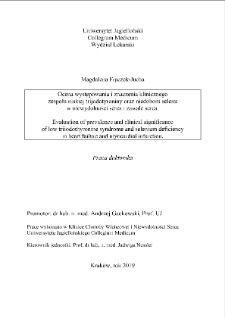Object
Title: Evaluation of prevalence and clinical significance of low triiodothyronine syndrome and selenium deficiency in heart failure and myocardial infarction
Abstract:
Introduction: Both glutathione peroxidase and deiodinases are selenoproteins requiring selenium (Se). Oxidative stress accompanying myocardial infarction (MI) and heart failure (HF) may lead to activation of peroxidase, Se deficiency and impair conversion of tetraiodothyronine (T4) to triiodothyronine (T3). The aim of the study was the evaluation of the prevalence and clinical significance of low T3 syndrome in MI and HF in relation to Se deficiency. Methods: The study group: 59 patients hospitalized due to decompensation of advanced HFrEF, NYHA III or IV and 59 patients hospitalized because of MI, treated with primary coronary angioplasty. Exclusion criteria: thyroid diseases, serious systemic disease, treatment with amiodarone, steroids of propranolol. The control group: 30 asymptomatic volunteers with normal ECG. Results: The prevalence of low T3 syndrome in HF was 15.3%, in acute MI- 11.9%, in the control group – 0%. The prevalence of Se deficiency was present in 74.58% HF patients, 70.37% MI patients and in 10.0% participants of the control group. There were lowered fT3 levels and fT3/fT4 ratio in HF and MI in comparison with the control group. In MI and HF time changes of TSH and/or HT were observed. Dependence between fT3 levels, fT3/fT4 ratio and clinical parameters of myocardial injury severity in MI and parameters of heart disfunction severity in HF was documented. Th ; ere are conflicting results about dependence between Se and HT. Conclusions: It was revealed that there is relationship between low T3 syndrome and unfavorable course of HF, while no dependence between Se and unfavorable course of HF and MI was found.
Place of publishing:
Level of degree:
Degree discipline:
Degree grantor:
Promoter:
Date issued:
Identifier:
Call number:
Language:
Access rights:
Object collections:
Last modified:
Apr 8, 2024
In our library since:
Apr 21, 2021
Number of object content hits:
8
Number of object content views in PDF format
0
All available object's versions:
http://dl.cm-uj.krakow.pl:8080/publication/4419
Show description in RDF format:
Show description in OAI-PMH format:
| Edition name | Date |
|---|---|
| ZB-132337 | Apr 8, 2024 |
Objects
Similar
Frączek‑Jucha, Magdalena
Węgiel, Michał Jan
Palka, Ilona
Misztal, Marcin
Gąsior,Mariusz (oprac ).
Brzeziński, Michał
Żygadło, Agnieszka
Stompór, Małgorzata

